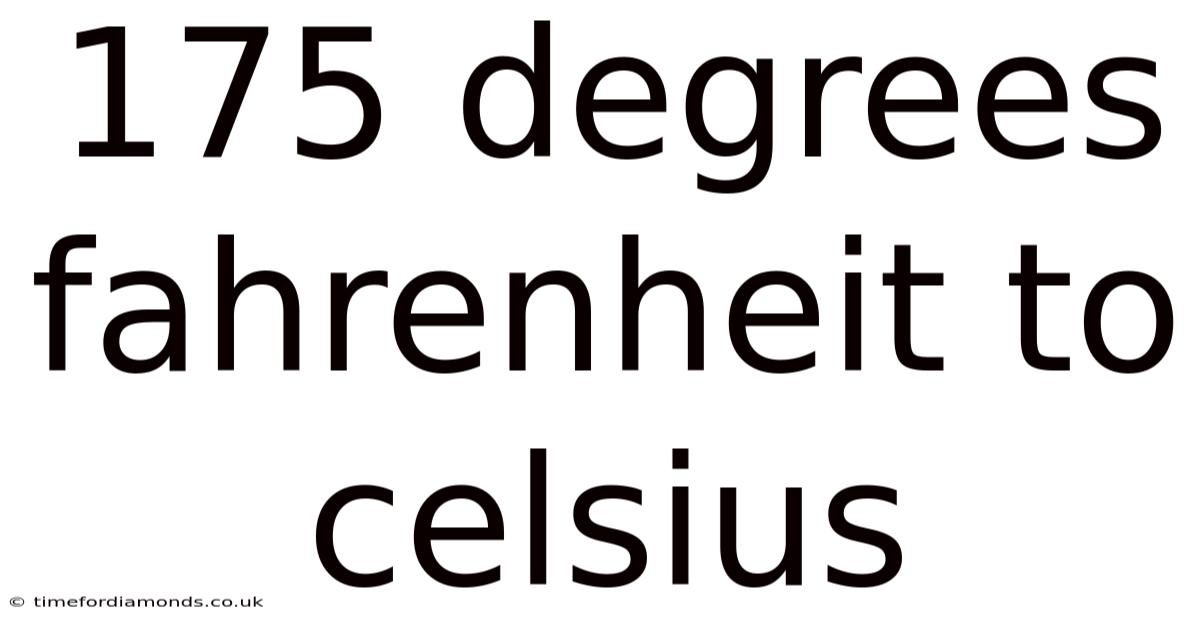175 Degrees Fahrenheit To Celsius
timefordiamonds
Sep 22, 2025 · 5 min read

Table of Contents
175 Degrees Fahrenheit to Celsius: A Comprehensive Guide
Converting between Fahrenheit and Celsius is a common task, especially for those working with cooking, science, or international collaborations. Understanding this conversion isn't just about plugging numbers into a formula; it’s about grasping the underlying principles of temperature scales and their practical applications. This comprehensive guide will not only show you how to convert 175°F to Celsius but also delve into the history of these scales, explain the conversion process in detail, and address frequently asked questions. By the end, you’ll have a firm understanding of temperature scales and the ability to confidently perform these conversions.
Understanding Temperature Scales: Fahrenheit vs. Celsius
Before diving into the conversion, let's briefly explore the history and differences between Fahrenheit and Celsius scales.
-
Fahrenheit (°F): Developed by Daniel Gabriel Fahrenheit in the early 18th century, this scale defines the freezing point of water as 32°F and the boiling point as 212°F, at standard atmospheric pressure. It’s still predominantly used in the United States, although its use is declining globally.
-
Celsius (°C) / Centigrade: Developed by Anders Celsius in the 18th century, this scale sets the freezing point of water at 0°C and the boiling point at 100°C, also at standard atmospheric pressure. This scale, also known as centigrade, is the most widely used temperature scale globally and is the standard unit of temperature in the International System of Units (SI).
The key difference lies in the scale's range and the points assigned to water's freezing and boiling points. This leads to different numerical values for the same temperature.
Converting 175°F to Celsius: The Process
The formula for converting Fahrenheit (°F) to Celsius (°C) is:
°C = (°F - 32) × 5/9
Let's apply this to convert 175°F:
°C = (175 - 32) × 5/9
°C = 143 × 5/9
°C = 715/9
°C ≈ 79.44°C
Therefore, 175 degrees Fahrenheit is approximately equal to 79.44 degrees Celsius.
A Deeper Dive into the Conversion Formula
The formula's components are crucial for understanding why it works:
-
(°F - 32): This part adjusts for the difference in the freezing point between the two scales. Fahrenheit starts at 32° where Celsius starts at 0°. Subtracting 32 aligns the starting points.
-
× 5/9: This factor accounts for the different scales' sizes. There are 180 degrees between the freezing and boiling points of water in Fahrenheit (212°F - 32°F = 180°F) and 100 degrees in Celsius (100°C - 0°C = 100°C). The ratio 5/9 (or 100/180 simplified) scales the Fahrenheit range to fit the Celsius range.
Practical Applications of 175°F (79.44°C)
Understanding the equivalent Celsius temperature of 175°F has many practical applications:
-
Cooking: Many recipes specify temperatures in Fahrenheit. Knowing the Celsius equivalent is essential for cooks using Celsius-based ovens or thermometers. 79.44°C is a relatively high temperature, often used for baking or deep-frying.
-
Science and Engineering: Scientific experiments and engineering processes often require precise temperature control. Conversion between Fahrenheit and Celsius is crucial for consistent results and accurate data interpretation.
-
International Collaboration: When working on projects involving international teams, consistent use of either Fahrenheit or Celsius is necessary to avoid misunderstandings and errors.
-
Medical Applications: While Celsius is the preferred scale in most medical applications globally, understanding Fahrenheit conversions can be vital in specific situations or when dealing with older medical equipment.
Beyond the Conversion: Understanding Heat and Temperature
It's important to distinguish between heat and temperature. While often used interchangeably, they represent different concepts:
-
Heat: Heat is the transfer of thermal energy between objects at different temperatures. It's a form of energy that flows from hotter to colder objects.
-
Temperature: Temperature measures the average kinetic energy of the particles within a substance. Higher temperature means particles are moving faster.
The conversion between Fahrenheit and Celsius only deals with temperature, not the actual amount of heat present. A large object at 79.44°C will contain significantly more heat energy than a small object at the same temperature.
Frequently Asked Questions (FAQs)
- Q: Can I use an online converter instead of the formula?
A: Absolutely! Many online converters are available, offering quick and accurate conversions. However, understanding the underlying formula is beneficial for deeper comprehension and problem-solving abilities.
- Q: What if I need to convert Celsius to Fahrenheit?
A: The reverse conversion uses the formula: °F = (°C × 9/5) + 32
- Q: Are there other temperature scales besides Fahrenheit and Celsius?
A: Yes! The Kelvin scale is a fundamental scale in thermodynamics, setting absolute zero (0 K) as the lowest possible temperature. Other historical scales exist but are less commonly used.
- Q: Why is the conversion not always precise?
A: The slight variations you might encounter using the formula are often due to rounding during calculations.
Conclusion: Mastering Temperature Conversions
Converting 175°F to Celsius (approximately 79.44°C) is more than a simple mathematical exercise. It's about understanding the relationship between two different temperature scales and their implications in various fields. This guide provided a thorough explanation of the conversion process, the underlying principles, and practical applications, equipping you with a solid foundation for handling temperature conversions confidently in the future. Remember that while tools like online calculators are helpful, mastering the conversion formula empowers you with a deeper understanding of the concepts involved. This knowledge is valuable not just for practical tasks but also for expanding your understanding of the fundamental principles of physics and the world around us.
Latest Posts
Related Post
Thank you for visiting our website which covers about 175 Degrees Fahrenheit To Celsius . We hope the information provided has been useful to you. Feel free to contact us if you have any questions or need further assistance. See you next time and don't miss to bookmark.